Today we are going to look at a rather boring topic, but without understanding it is impossible to go any further. This topic is called "rounding numbers" or "approximation".
Approximate values
Approximate values are used when the exact value of something cannot be found, or it is not important that the value be exact for the exercise.
For example, you might say in words that half a million people live in the city, but this statement will not be true, because the number of people in the city changes - people come and go, people are born and die. Therefore, it is more accurate to say that approximately half a million people live in the city.
Another example. The class starts at nine in the morning. We left the house at 8:30. After a while on the way, we met a friend of ours who asked us what time it was. When we left the house it was 8:30, it took us some unknown time to get there. We don't know what time it is, so we answer the comrade: "it's about nine o'clock".
In mathematics, approximation (rounding) is indicated by a special sign. It looks like this:
![]()
read like "approximately equal".
To specify an approximate value, you should use rounding.
Rounding numbers
To find an approximate value such action as rounding numbers is applied.
The word "rounding" speaks for itself.
Rounding means making a number simpler but keeping its value close to what it was. For example, the following numbers are rounded:
10, 20, 30, 100, 300, 700, 1000
Any number can be rounded. The procedure by which a number is rounded is called rounding a number.
We already dealt with "rounding" numbers when we divided large numbers. Recall that in order to do this, we left unchanged the digit that forms the largest digit, and replaced the other digits with zeros. But these were just lifehacks we used to make division easier. In fact, it wasn't even rounding numbers. That is why we put the word rounding in quotes at the beginning of this paragraph.
In fact, the meaning of rounding is to find the nearest value from the original in order to make it simpler. In this case, the number can be rounded to a certain digit - tens, hundreds, thousands.
Consider a simple example of rounding. We have a number 17. We need to round it to tens.
Let's try to understand what "round to tens" means. When they say to round number 17, you should understand that we are required to find the closest round number to the number 17.
Let's represent numbers from 10 to 20 using the following picture:
![]()
You can see in the picture that the nearest round number for number 17 is 20. So the answer to the problem is: "17 approximates 20″.
17 ≈ 20
We found an approximate value for 17, that is, we rounded it to tens. You can see that after rounding a new digit 2 appeared in the digit of tens.
Let's try to find an approximate number for number 12. To do this, we again represent the numbers from 10 to 20 with the help of the figure:
![]()
The figure shows that the nearest round number for 12 is 10. So the answer to the problem is: 12 approximates 10
12 ≈ 10
We found an approximate value for 12, that is, we rounded it to the digit of tens. This time the number 1, which was in the place of tens in the number 12, was not affected by rounding. We will tell you later why it happened that way.
Let's try to find the closest number to number 15. Again, use the picture to represent numbers from 10 to 20:
![]()
In the picture you can see that number 15 is equally distant from the round numbers 10 and 20. The question arises: which of these round numbers is an approximation for number 15? For such cases, we have agreed to take the larger number as an approximation. 20 is bigger than 10, so the approximate value for 15 is 20.
15 ≈ 20
It is possible to round large numbers as well. For example, let's round the number 1456 to tens.
So, we have to round 1456 to the place of tens. The digit of tens starts at five:

Now we temporarily forget about the existence of the first digits 1 and 4. This leaves the number 56
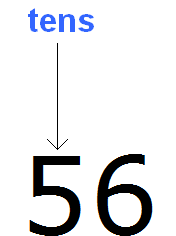
Now see which round number is closer to the number 56. Obviously, the closest round number to 56 is 60. So we replace number 56 with number 60

So if we round the number 1456 to the place of tens we get 1460
1456 ≈ 1460
You can see that after rounding the number 1456 to the digit of tens, changes affected the digit of tens itself. In the new number obtained, the digit in the place of tens is now 6, not 5.
It is not only possible to round numbers to the number of tens. You can round numbers to the range of hundreds, thousands, tens of thousands, and so on.
Once it is clear that rounding is nothing more than finding the nearest number, you can apply ready-made rules that make rounding numbers much easier.
First rule of rounding
In the previous examples, we saw that by rounding a number to a certain digit, the lowest digits are replaced by zeros. The digits which are replaced by zeros are called discarded digits.
The first rounding rule is as follows:
If the number you are rounding is followed by 0, 1, 2, 3, or 4, round the number down.
For example, round the number 123 to the place of tens.
The first thing we do is to find the digit to save. To do this we need to read the task itself. In the digit which is mentioned in the task there is a stored digit. The task says to round the number 123 to the digit of tens.
We see that there is a 2 in the place of tens. So the stored digit is the digit 2
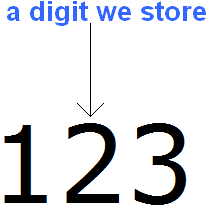
Now find the first of the discarded digits. The first of the discarded digits is the digit that follows the stored digit. We see that the first digit after the two is digit 3. So the digit 3 is the first discarded digit.
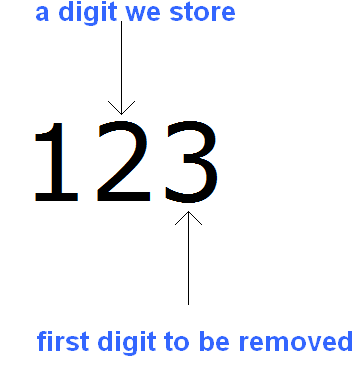
Now we apply the rounding rule. It says that if when rounding numbers, the first of the discarded digits is 0, 1, 2, 3 or 4, then the retained digit remains unchanged.
This is what we do. We leave the stored digit unchanged, and replace all low-order bits with zeros. In other words, we replace everything after digit 2 with zeros (zero, to be exact):
123 ≈ 120
So if we round the number 123 to the place of tens, we get an approximation of 120.
Now let's try to round the same number 123, but in the hundreds.
We need to round the number 123 to the hundredth place. Again we look for the stored digit. This time the stored digit is 1, since we are rounding the number to the hundredth digit.
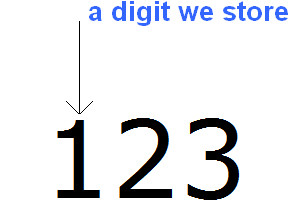
Now find the first of the discarded digits. The first of the discarded digits is the digit that follows the stored digit. We see that the first digit after one is digit 2. So the digit 2 is the first discarded digit:

Now let's apply the rule. It says that if when rounding numbers, the first digit to be discarded is 0, 1, 2, 3, or 4, then the digit to be retained remains unchanged.
This is what we do. We leave the stored digit unchanged and replace all low-order bits with zeros. In other words, replace everything after the number 1 with zeros:
123 ≈ 100
So if you round the number 123 to the hundredth place, you get an approximation of 100.
Example 3. Round the number 1234 to the place of tens.
Here the stored digit is 3. The first digit to be discarded is 4. According to the rule, if the first digit to be rounded is 0, 1, 2, 3 or 4, then the digit to be kept remains unchanged.
So we leave the stored digit 3 unchanged, and replace everything after it with zero:
1234 ≈ 1230
Example 4. Round the number 1234 to the hundredth place.
Here the stored digit is 2. The first digit to be discarded is 3. According to the rule, if the first digit to be rounded is 0, 1, 2, 3 or 4, then the digit to be kept remains unchanged.
So we leave the stored digit 2 unchanged and replace everything after it with zeros:
1234 ≈ 1200
Example 5. Round the number 1234 to the thousandth place.
Here the digit to be saved is 1. The first digit to be discarded is 2. According to the rule, if the first digit to be rounded is 0, 1, 2, 3 or 4, then the digit to be kept remains unchanged.
So we leave the stored digit 1 unchanged and replace everything after it with zeros:
1234 ≈ 1000
Second rule of rounding
The second rounding rule is as follows:
If the number you are rounding is followed by 5, 6, 7, 8, or 9, round the number up
For example, round the number 675 to the place of tens.
The first thing we do is to find the digit to save. To do this we need to read the task itself. In the digit, which is mentioned in the task, there is a stored digit. The task says to round the number 675 to the digit of tens.
We see that there is a seven in the place of tens. So the stored digit is the digit 7
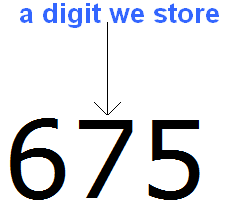
Now find the first of the discarded digits. The first of the discarded digits is the digit that follows the stored digit. We see that the first digit after the seven is digit 5. So the digit 5 is the first discarded digit.

Now we apply the second rounding rule. It says that if when rounding numbers, the first of the discarded digits is 5, 6, 7, 8 or 9, then the retained digit is incremented by one.
Our first digit to be discarded is 5. So we must increase the stored digit 7 by one, and replace everything after it with zero:
675 ≈ 680
So if you round the number 675 to the digit of tens, you get an approximation of 680.
Now let's try rounding the same number 675, but to the level of hundreds.
We need to round the number 675 to the hundredth place. Again we look for the stored digit. This time the stored digit is 6, since we are rounding the number to the digit of hundreds:
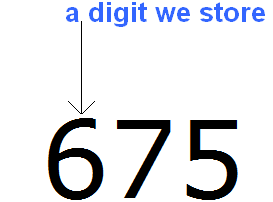
Now find the first of the discarded digits. The first of the discarded digits is the digit that follows the stored digit. We see that the first digit after the six is digit 7. This means that digit 7 is the first digit to be discarded:
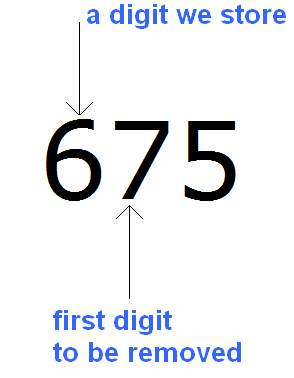
Now we apply the second rounding rule. It says that when rounding numbers, if the first of the discarded digits is 5, 6, 7, 8, or 9, then the digit to be retained is incremented by one.
In our case, the first digit to be rounded is a 7. So we must increase by one the stored digit 6 and replace everything after it with zeros:
675 ≈ 700
So if you round the number 675 to the hundredth digit, you get an approximation of 700.
Example 3. Round the number 9876 to the place of tens.
Here the stored digit is 7. The first digit to be discarded is 6. According to the rule, if the first digit to be rounded is 5, 6, 7, 8 or 9, then the digit to be kept is incremented by one.
So we increase by one the stored digit 7 and replace everything after it with zero:
9876 ≈ 9880
Example 4. Round the number 9876 to the hundredth place.
Here the digit to be saved is 8. The first digit to be discarded is 7. According to the rule, if the first digit to be rounded is 5, 6, 7, 8 or 9, then the digit to be retained is incremented by one.
So we increase by one the stored digit 8 and replace everything after it with zeros:
9876 ≈ 9900
Example 5. Round the number 9876 to the thousandth place.
Here the digit to be saved is 9. The first digit to be discarded is 8. According to the rule, if the first digit to be rounded is 5, 6, 7, 8 or 9, then the stored digit is incremented by one.
So we increase by one the stored digit 9 and replace everything after it with zeros:
9876 ≈ 10000
Example 6: Round the number 2971 to hundreds.
Be careful when rounding this number to hundreds, because the retained digit here is 9, and the first digit to be discarded is 7. So the number 9 should be incremented by one. But the thing is, after the increase of nine by one you will get 10, and this digit will not fit in the hundreds digit of the new number.
In this case, in the digit of hundreds of the new number you need to write 0, and the unit is moved to the next digit and added to the digit that is there. Then replace all digits after the stored one with zeros:

2971 ≈ 3000
Rounding decimals
When rounding decimals, you should be especially careful, because a decimal consists of a whole part and a fractional part. And each of these two parts has its ownplace values:
Whole place value:
- ones;
- tens;
- hundreds;
- thousands.
Fractional Part place value:
- tenths;
- hundredths;
- thousandths
Consider the decimal 123.456 - one hundred and twenty-three whole four hundred and fifty-six thousandths. Here the whole part is 123 and the fractional part is 456. Each of these parts has its own digits.

The same rounding rules apply to the whole part as to regular numbers. The difference is that after rounding the whole part and replacing all digits after the stored digit with zeros, the fractional part is completely discarded.
For example, round the decimal 123.456 to the place of tenth. It is very important not to mix up these digits. The digit of tens is in the whole part, and the digit of tens in the fractional part.
So, we have to round 123.456 to the place of tens. The stored digit here is 2, and the first of the discarded digits is 3
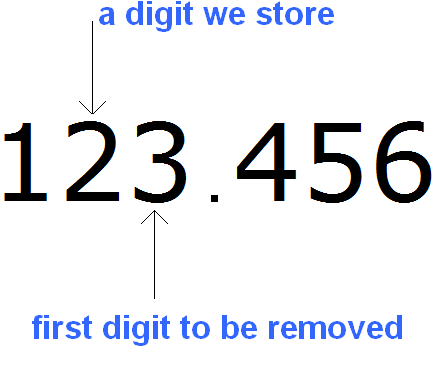
According to the rule, if the number you are rounding is followed by 0, 1, 2, 3 or 4, then the digit to be retained remains unchanged.
So the stored digit will remain unchanged and everything else will be replaced by zero. What about the fractional part? It is simply discarded (removed):
123.456 ≈ 120
Now let's try to round the same decimal 123.456 to ones. The retained digit here will be 3, and the first of the discarded digits is 4, which is in the fractional part:
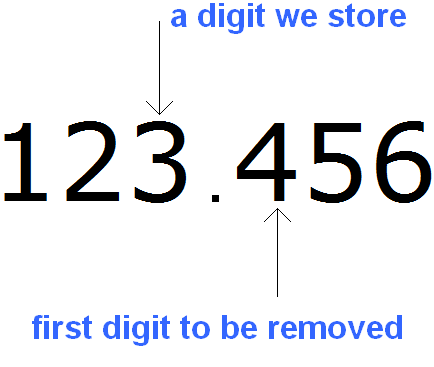
According to the rule, if the first digit to be discarded is 0, 1, 2, 3 or 4 when rounding a number, then the digit to be retained remains unchanged.
So the retained digit will remain unchanged and everything else will be replaced by zero. The remaining fractional part will be discarded:
123.456 ≈ 123.0
The zero left after the decimal point can also be discarded. So the final answer will look like this:
123.456 ≈ 123.0 ≈ 123
Now let's deal with rounding of decimals. The same rules are valid for rounding fractions as for rounding integers. Let's try to round the fraction 123.456 to the decimal place. In the place of tenths there is digit 4, so it is a retained digit, and the first digit to be discarded is 5, which is in the place of hundredths:

According to the rule, if when rounding numbers, the first of the discarded digits is 5, 6, 7, 8 or 9, then the stored digit is incremented by one.
So the stored digit 4 will be incremented by one and the rest will be replaced by zeros
123.456 ≈ 123.500
Let us try to round the same fraction 123.456 to the hundredth place. The retained digit here is 5, and the first of the discarded digits is 6, which is in the thousandths digit:

According to the rule, if when rounding numbers, the first of the discarded digits is 5, 6, 7, 8 or 9, then the stored digit is incremented by one.
So the retained digit 5 will be incremented by one and the rest will be replaced by zeros
123.456 ≈ 123.460
Comments